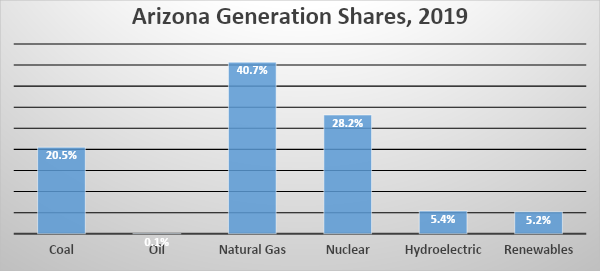Arizona utility regulators approved new rules mandating electric companies to provide 100 percent carbon-free energy by 2050, with interim benchmarks. Arizona joins other states in this endeavor including New York and neighboring California. Unlike other states, the new rules do not include a requirement for utilities to use a specified amount of renewable energy, such as solar and wind. They do, however, include energy efficiency requirements and battery storage policies for utilities. Utilities can meet the new rules by generating electricity using renewable energy and/or nuclear power and by reducing demand through energy-efficiency measures.
The new rules update the state’s 2006 Renewable Energy Standard and Tariff, which required utilities to get 15 percent of their power from renewable energy by 2025, and the 2010 energy-efficiency requirements to use efficiency measures to meet 22 percent of energy demand by this year.
More specifically, electric utilities:
- Will have to phase out coal- and natural-gas-burning power plants, with interim requirements to cut carbon dioxide emissions in half by 2032 and by 75 percent by 2040. The reductions are based on the amount of carbon dioxide a utility’s power plants emitted on average from 2016 to 2018.
- Are required to implement energy-efficiency measures by 2030 that equal 35 percent of their 2020 peak demand with interim requirements to ensure utilities are working toward that goal annually.
- Will have to plan and build new power plants or make power purchase arrangements with other generators that are transparent and competitive and that meet the requirements of the regulators.
Next steps include:
- The Corporation Commission staff will submit a notice of the proposed rules to the Secretary of State. The order includes dates for public comments.
- In January, the commission will file an economic impact analysis on the rules.
- Next year, an administrative-law judge will issue a recommended order stating the rules are set, and the commission votes again on the rules.
New Commissioners
Three commissioners who won election in 2020 will begin their term next year. The three election winners will join Democrat Sandra Kennedy, who supports more renewable energy, and Republican Justin Olson, who voted against the new mandates. Thus, next year, the commission will include two Republicans in Olson and newly elected Jim O’Connor who do not believe that the commission should be setting requirements for renewable energy. It will have two Democrats in Kennedy and newly elected Anna Tovar who advocate for stricter renewable-energy requirements.
That leaves newly elected Republican Lea Marquez Peterson, who supports the additional energy-efficiency requirements and the zero-carbon goal for 2050. She is opposed to new rules that would additionally require a certain percentage of electric utilities’ power supply to come from renewables like solar and wind – not just carbon-free sources—which also include nuclear and energy efficiency projects. For that reason, the current commission did not increase the percentage required from renewable energy.
Ratepayers Beware
Some of the commissioners believe that the new rule is a job creator and that the rule will benefit the state’s ratepayers. Given that the state will have to prematurely retire its existing coal and natural gas units and replace them with either new renewable energy and nuclear power or demand reductions from energy efficiency projects, it is not likely to benefit ratepayers. New nuclear power is expensive, energy efficiency projects usually have a rebound affect that has consumers using more than the expected reduction, and states with renewable energy standards have realized higher electricity prices after they constructed wind and solar units.
Arizona generated 61 percent of its electricity from coal and natural gas last year, while non-hydroelectric renewable energy generated only 5 percent, nuclear power 28 percent and hydroelectricity 5 percent. Phasing out coal and natural gas units and building solar and wind units, which are less expensive than nuclear power, will likely raise electricity prices. Residential electricity prices in California, for example, are almost 50 percent higher than the average residential electricity price in the nation (19.22 cents per kilowatt-hour compared to 13.04 cents per kilowatt-hour) and the seventh-highest residential electricity price in the nation. Arizona’s average residential electricity price was even less than the national average residential electricity price in 2019 at 12.55 cents per kilowatt hour.

Not only will Arizona see higher electricity prices, but they may also be confronted with the possibility of rolling blackouts as the residents of California faced in August. California generated 30 percent of its electricity from non-hydroelectric sources in 2019—6 times more than Arizona. When wind and solar units do not produce sufficient power, California buys power from neighboring states like Arizona, but the August heat wave affected the neighboring states’ energy demand and they had no excess power to sell. As such, California’s grid operator had to resort to rolling blackouts. If Arizona is placed in a similar situation, it will obviously not be able to rely upon California to purchase sufficient power. Wind and solar units only produce power when the sun is shining and the wind is blowing; they are not available 24/7, when Americans expect electric power to be available.
Conclusion
Arizona residents need to be aware and not fall into the trap that some of their commissioners want them to believe: that carbon free electricity will be no more expensive than their current electricity system. New nuclear power is expensive and states with renewable energy standards have seen their electricity prices increase. California, for example, has the seventh highest residential electricity prices in the nation and generates 30 percent of its power from non-hydroelectric renewables.



